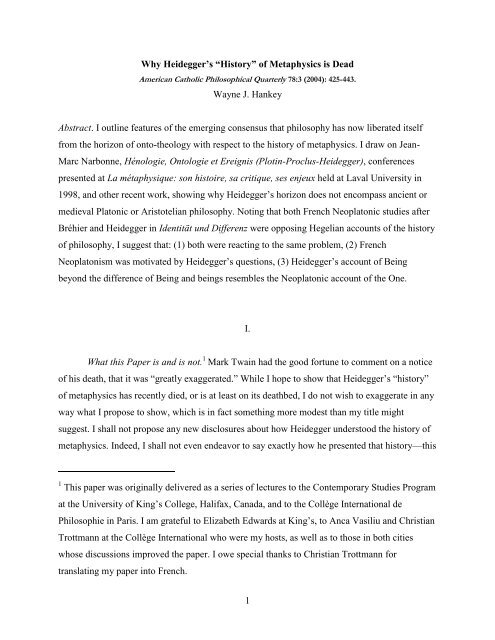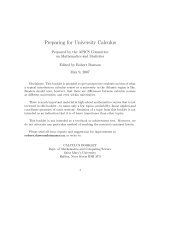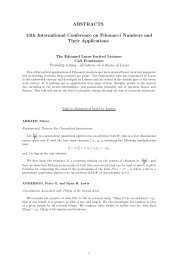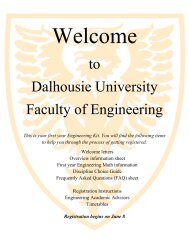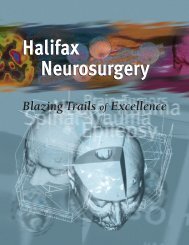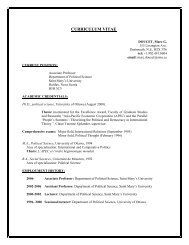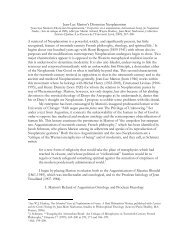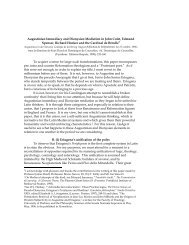Why Heidegger's 'History' of Metaphysics is Dead - Dalhousie ...
Why Heidegger's 'History' of Metaphysics is Dead - Dalhousie ...
Why Heidegger's 'History' of Metaphysics is Dead - Dalhousie ...
Create successful ePaper yourself
Turn your PDF publications into a flip-book with our unique Google optimized e-Paper software.
<strong>Why</strong> Heidegger’s “H<strong>is</strong>tory” <strong>of</strong> <strong>Metaphysics</strong> <strong>is</strong> <strong>Dead</strong><br />
American Catholic Philosophical Quarterly 78:3 (2004): 425-443.<br />
Wayne J. Hankey<br />
Abstract. I outline features <strong>of</strong> the emerging consensus that philosophy has now liberated itself<br />
from the horizon <strong>of</strong> onto-theology with respect to the h<strong>is</strong>tory <strong>of</strong> metaphysics. I draw on Jean-<br />
Marc Narbonne, Hénologie, Ontologie et Ereign<strong>is</strong> (Plotin-Proclus-Heidegger), conferences<br />
presented at La métaphysique: son h<strong>is</strong>toire, sa critique, ses enjeux held at Laval University in<br />
1998, and other recent work, showing why Heidegger’s horizon does not encompass ancient or<br />
medieval Platonic or Ar<strong>is</strong>totelian philosophy. Noting that both French Neoplatonic studies after<br />
Bréhier and Heidegger in Identität und Differenz were opposing Hegelian accounts <strong>of</strong> the h<strong>is</strong>tory<br />
<strong>of</strong> philosophy, I suggest that: (1) both were reacting to the same problem, (2) French<br />
Neoplaton<strong>is</strong>m was motivated by Heidegger’s questions, (3) Heidegger’s account <strong>of</strong> Being<br />
beyond the difference <strong>of</strong> Being and beings resembles the Neoplatonic account <strong>of</strong> the One.<br />
I.<br />
What th<strong>is</strong> Paper <strong>is</strong> and <strong>is</strong> not. 1 Mark Twain had the good fortune to comment on a notice<br />
<strong>of</strong> h<strong>is</strong> death, that it was “greatly exaggerated.” While I hope to show that Heidegger’s “h<strong>is</strong>tory”<br />
<strong>of</strong> metaphysics has recently died, or <strong>is</strong> at least on its deathbed, I do not w<strong>is</strong>h to exaggerate in any<br />
way what I propose to show, which <strong>is</strong> in fact something more modest than my title might<br />
suggest. I shall not propose any new d<strong>is</strong>closures about how Heidegger understood the h<strong>is</strong>tory <strong>of</strong><br />
metaphysics. Indeed, I shall not even endeavor to say exactly how he presented that h<strong>is</strong>tory—th<strong>is</strong><br />
1 Th<strong>is</strong> paper was originally delivered as a series <strong>of</strong> lectures to the Contemporary Studies Program<br />
at the University <strong>of</strong> King’s College, Halifax, Canada, and to the Collège International de<br />
Philosophie in Par<strong>is</strong>. I am grateful to Elizabeth Edwards at King’s, to Anca Vasiliu and Chr<strong>is</strong>tian<br />
Trottmann at the Collège International who were my hosts, as well as to those in both cities<br />
whose d<strong>is</strong>cussions improved the paper. I owe special thanks to Chr<strong>is</strong>tian Trottmann for<br />
translating my paper into French.<br />
1
eing a matter so d<strong>is</strong>puted that treating it would consume all my efforts. What I shall propose,<br />
partly from out <strong>of</strong> French writings and partly out <strong>of</strong> Engl<strong>is</strong>h ones, together with some German<br />
references, will depend upon many diverse, and even contradictory, representations <strong>of</strong><br />
Heidegger’s h<strong>is</strong>tory <strong>of</strong> metaphysics. These assumed, I shall consider how that h<strong>is</strong>tory determines<br />
some contemporary philosophical, theological, and even religious reflections and constructions,<br />
and I shall endeavor to plot their vector. In consequence, I shall speak very little about what<br />
Heidegger thought, and almost equally little about how h<strong>is</strong> thought <strong>is</strong> represented. Rather, I shall<br />
center on reactions to these representations. My attention <strong>is</strong> quite specific. I shall attend to the<br />
connection between Heidegger’s understanding <strong>of</strong> the h<strong>is</strong>tory <strong>of</strong> metaphysics and its so-called<br />
onto-theological structure. Further, my concentration will be on the relations which that<br />
connection implies between metaphysics, theology, the gods, and faith.<br />
My reflections do not come out <strong>of</strong> any proper consideration <strong>of</strong> contemporary philosophy<br />
for its own sake, and on th<strong>is</strong> I pretend no expert<strong>is</strong>e. Rather, they arose first out <strong>of</strong> a study <strong>of</strong><br />
Thomas Aquinas, specifically <strong>of</strong> what <strong>is</strong> Neoplatonic in h<strong>is</strong> thinking. From th<strong>is</strong> beginning I went<br />
on to consider the h<strong>is</strong>tory <strong>of</strong> Neoplaton<strong>is</strong>m, and why Thom<strong>is</strong>ts had excluded Aquinas from it; I<br />
then noted a remarkable shift during the last century, during which Aquinas was more and more<br />
looked at through Neoplatonic structures. We observe a remarkable coincidence: During th<strong>is</strong><br />
same period, in the so-called “Continental” tradition <strong>of</strong> philosophy, the most important thinking<br />
about Aquinas’ doctrine <strong>of</strong> God has rotated around Heidegger’s inqu<strong>is</strong>ition <strong>of</strong> Western<br />
philosophical theology and the h<strong>is</strong>tory <strong>of</strong> metaphysics under the figure <strong>of</strong> onto-theology. 2 The<br />
most important h<strong>is</strong>torical scholarship on Aquinas <strong>is</strong> found in the same tradition. Thus, we are<br />
brought to reflect on the relation between a Neoplatonic representation <strong>of</strong> Aquinas and the<br />
appearance <strong>of</strong> h<strong>is</strong> thought within a Heideggerian framework. 3 The concentration <strong>of</strong> my studies<br />
on Aquinas gave me an advantageous perspective: for better or worse, he <strong>is</strong> for very many the<br />
2 See Fergus Kerr, After Aquinas: Versions <strong>of</strong> Thom<strong>is</strong>m (Oxford: Blackwell, 2002), 86.<br />
3 For how Aquinas fits in it, see W. J. Hankey, God in Himself: Aquinas’ Doctrine <strong>of</strong> God as<br />
Expounded in the Summa Theologiae, Oxford Theological Monographs/Oxford Scholarly<br />
Classics (Oxford: Oxford University Press, 1987; 2000), and idem, “Theoria versus Poiês<strong>is</strong>:<br />
Neoplaton<strong>is</strong>m and Trinitarian Difference in Aquinas, John Milbank, Jean-Luc Marion and John<br />
Zizioulas,” Modern Theology 15/4 (October 1999): 387–415.<br />
2
high point in the union <strong>of</strong> metaphysics as onto-theology and Chr<strong>is</strong>tianity. In consequence, the<br />
most interesting questions Heidegger inspires occur concerning Aquinas. In addition, there <strong>is</strong><br />
more generally, in our time, a connection between diverse retrievals <strong>of</strong> Neoplaton<strong>is</strong>m and the<br />
influence <strong>of</strong> Heidegger’s philosophy. The connection <strong>is</strong>, however, ironic. I hope to show in th<strong>is</strong><br />
paper that the h<strong>is</strong>torical reflections and retrievals which Heidegger inspires are also fatal for h<strong>is</strong><br />
representation <strong>of</strong> the h<strong>is</strong>tory <strong>of</strong> metaphysics.<br />
II.<br />
The Ironic Connection between Neoplaton<strong>is</strong>m and Heidegger’s Influence. For much <strong>of</strong><br />
the philosophical and theological world in the greater part <strong>of</strong> the last century, Heidegger both<br />
inspired positively and negatively the study <strong>of</strong> the h<strong>is</strong>tory <strong>of</strong> philosophy and theology and also<br />
motivated various retrievals <strong>of</strong> moments from its past. Asking about th<strong>is</strong> inspiration produces a<br />
paradoxical question: How it <strong>is</strong> that Heidegger’s Seinsfrage did so much to inspire both the study<br />
and the retrieval <strong>of</strong> Neoplaton<strong>is</strong>m while negatively m<strong>is</strong>representing it (mostly by neglecting its<br />
specific character)? Philosophers, theologians, and scholars either presented Platon<strong>is</strong>m and its<br />
h<strong>is</strong>tory in order to reveal the faults <strong>of</strong> Heidegger’s account, or they turned to Neoplaton<strong>is</strong>m,<br />
having accepted Heidegger’s critique <strong>of</strong> metaphysics as onto-theology, in order to find an<br />
alternative way for Western philosophy, theology, and religion. Our understanding <strong>of</strong> Aquinas<br />
was much affected and tends to fall within a few alternatives: (1) Either these Neoplaton<strong>is</strong>ms<br />
emerged in opposition to Thom<strong>is</strong>m as the exemplar <strong>of</strong> the worst onto-theological metaphysics;<br />
(2) or, alternatively, Aquinas’ own thought was reinterpreted in a Neoplatonic fashion, using h<strong>is</strong><br />
connection to the Pseudo-Dionysius in order to turn the thought <strong>of</strong> Aquinas into a negative<br />
theology, so as to make it appear as the very opposite <strong>of</strong> such ontological Thom<strong>is</strong>m; (3) or, in a<br />
more balanced approach, Aquinas’ thought was located with respect to a Platonic henology, on<br />
the one hand, and to an Ar<strong>is</strong>totelian “metaphysics <strong>of</strong> pure being,” on the other hand, both<br />
constructions <strong>of</strong> a h<strong>is</strong>tory <strong>of</strong> metaphysics rethought through Neoplaton<strong>is</strong>m. 4 Whichever <strong>of</strong> these<br />
4 See E. Tourpe, “Thomas et la modernité. Un point de vue spéculatif sur l’h<strong>is</strong>toire de la<br />
métaphysique thom<strong>is</strong>te,” Revue des sciences philosophiques et théologiques 85/3 (July 2001):<br />
433–60; Wayne J. Hankey, “Le rôle du néoplaton<strong>is</strong>me dans les tentatives postmodernes<br />
3
paths <strong>is</strong> taken in our time, Heidegger, the Neoplaton<strong>is</strong>ts, and Aquinas are intimately connected.<br />
Increasingly, however, the aim <strong>is</strong> not to make Aquinas or Neoplaton<strong>is</strong>m conform to what<br />
Heidegger’s h<strong>is</strong>tory <strong>of</strong> metaphysics and onto-theology would require, but in contrast, to call the<br />
Heideggerian h<strong>is</strong>tory itself, and the alternative fundamental philosophy to which it belongs, into<br />
question.<br />
Our view <strong>of</strong> h<strong>is</strong>tory <strong>is</strong> emerging out from under Heidegger’s pr<strong>of</strong>oundly restricting<br />
horizon. Not the least <strong>of</strong> the signs <strong>of</strong> th<strong>is</strong> development was the vector <strong>of</strong> the remarkable<br />
conjunction <strong>of</strong> philosophical, theological, h<strong>is</strong>torical, and philological work put together at<br />
Université Laval in 1998 for the twenty-seventh Congrès de l’Association des Sociétés de<br />
Philosophie de Langue França<strong>is</strong>e, whose complete proceedings were publ<strong>is</strong>hed in 2000. 5<br />
Subsequent to th<strong>is</strong> congress, and drawing upon a good many <strong>of</strong> the communications given there,<br />
Jean-Marc Narbonne’s Hénologie, Ontologie et Ereign<strong>is</strong> (Plotin-Proclus-Heidegger) appeared. 6<br />
d’échapper à l’onto-théologie,” in La métaphysique: son h<strong>is</strong>toire, sa critique, ses enjeux. Actes<br />
du XXVII e Congrès de l’Association des Sociétés de Philosophie de Langue França<strong>is</strong>e, ed. Luc<br />
Langlo<strong>is</strong> and Jean-Marc Narbonne (Par<strong>is</strong>: Vrin; Québec: Les Presses de l’Université Laval,<br />
2000), 36–43; idem, “Denys and Aquinas: Antimodern Cold and Postmodern Hot,” in Chr<strong>is</strong>tian<br />
Origins: Theology, Rhetoric and Community, ed. Lew<strong>is</strong> Ayres and Gareth Jones (London/New<br />
York: Routledge, 1998), 139–84, at 139–64; idem, “Dionysian Hierarchy in St. Thomas<br />
Aquinas: Tradition and Transformation,” in Denys l’Aréopagite et sa postérité en Orient et en<br />
Occident. Collection des Études Augustiniennes, Série Antiquité 151, ed. Ysabel de Andia<br />
(Par<strong>is</strong>: Institut d’Études Augustiniennes, 1997), 405–38, at 405–16.<br />
5 La métaphysique: son h<strong>is</strong>toire, sa critique, ses enjeux. Actes du XXVII e Congrès de l’<br />
Association des Sociétés de Philosophie de Langue França<strong>is</strong>e, ed. Luc Langlo<strong>is</strong> and Jean-Marc<br />
Narbonne (Par<strong>is</strong>: Vrin; Québec: Les Presses de l’Université Laval, 2000). The plenary sessions<br />
<strong>of</strong> th<strong>is</strong> conference were publ<strong>is</strong>hed initially in a separate volume one year earlier under the same<br />
title. See La métaphysique: son h<strong>is</strong>toire, sa critique, ses enjeux, ed. Luc Langlo<strong>is</strong> and Jean-Marc<br />
Narbonne, Collection Zêtês<strong>is</strong> (Par<strong>is</strong>: Vrin; Québec: Les Presses de l’Université Laval, 1999).<br />
6 Jean-Marc Narbonne, Hénologie, Ontologie et Ereign<strong>is</strong> (Plotin-Proclus-Heidegger), L’âne d’or<br />
(Par<strong>is</strong>: Les Belles Lettres, 2001). See also idem, “Heidegger et le néoplaton<strong>is</strong>me,” Heidegger e i<br />
medievali/Heidegger et la pensée médiévale/Heidegger und das mittelalterliche<br />
4
Narbonne considers henological Neoplaton<strong>is</strong>m—primarily through texts <strong>of</strong> Plotinus and<br />
Proclus—and the other great Western tradition <strong>of</strong> philosophical theology emerging from<br />
antiquity, the ontological. Th<strong>is</strong> “metaphysics <strong>of</strong> pure being,” or a “negative theology <strong>of</strong> being,”<br />
which also has its origins with Parmenides and Plato, <strong>is</strong> associated with Ar<strong>is</strong>totle. However, in<br />
the theologies <strong>of</strong> late antiquity (Chr<strong>is</strong>tian and pagan), <strong>of</strong> the Arabic and Latin Middle Ages, and<br />
<strong>of</strong> the Rena<strong>is</strong>sance, Ar<strong>is</strong>totle was rethought in a Neoplatonic context by way <strong>of</strong> the very<br />
widespread doctrine <strong>of</strong> the First Principle as pure being, einai or esse, which probably originates<br />
in Porphyry’s modification <strong>of</strong> Plotinus. 7 Narbonne chiefly treats its development through texts <strong>of</strong><br />
Pico della Mirandola and Thomas Aquinas. Throughout h<strong>is</strong> work, he critically examines both<br />
Denken/Heidegger and Medieval Thought, Atti del Colloquio Internationale Cassino 10–13<br />
maggio 2000, ed. Costantino Esposito and Pasquale Porro, in Quaestio 1 (2001): 55–82 (for a<br />
review <strong>of</strong> th<strong>is</strong> <strong>is</strong>sue <strong>of</strong> Quaestio and an important gathering <strong>of</strong> critic<strong>is</strong>m <strong>of</strong> the Heideggerian<br />
h<strong>is</strong>tory, see R. Imbach, “Heidegger et la philosophie médiévale,” Freiburger Zeitschrift für<br />
Philosophie und Theologie 49 [2002]: 426–34); Narbonne, “EPEKEINA THS GNWSEWS, le<br />
savoir d’au-delà à savoir chez Plotin et dans la tradition néoplatonicienne,” in Metaphysik und<br />
Religion : Zur Signatur des spätantiken Denkens, ed. Theo Kobusch and Michael Erler,<br />
(Munich/Leipzig: K. G. Saur, 2001), 477–90; idem, “‘Henôs<strong>is</strong>’ et ‘Ereign<strong>is</strong>’: Remarques sur une<br />
interprétation heideggérienne de l’Un plotinien,” Les Études philosophiques (1999): 108–21;<br />
idem, “Ar<strong>is</strong>tote et la question de l’être en tant qu’être. Réflexions à propos de The Question <strong>of</strong><br />
Being <strong>of</strong> S. Rosen,” Archives de Philosophie 60 (1997): 5–24. Narbonne <strong>is</strong> in dialogue with<br />
Reiner Schürmann, “L’hénologie comme dépassement de la métaphysique,” Les Études<br />
philosophiques (1982): 331–50.<br />
7 On h<strong>is</strong>torical and philosophical foundations laid by Pierre Hadot and Pierre Aubenque, see, for<br />
example, Mark D. Jordan, “The Grammar <strong>of</strong> Esse,” The Thom<strong>is</strong>t 44 (1980): 1–26; W. J. Hankey,<br />
“Aquinas’ First Principle, Being or Unity?” Dionysius 4 (1980): 133–72; K. Corrigan, “A<br />
Philosophical Precursor to the Theory <strong>of</strong> Essence and Ex<strong>is</strong>tence in St. Thomas Aquinas,” The<br />
Thom<strong>is</strong>t 48 (1984): 219–40; A. de Libera and C. Michon, L’Être et l’Essence. Le vocabulaire<br />
médiéval de l’ontologie. Deux traités De ente et essentia de Thomas d’Aquin et Dietrich de<br />
Freiberg (Par<strong>is</strong>: Seuil, 1986), 29–36; and D. Bradshaw, “Neoplatonic Origins <strong>of</strong> the Act <strong>of</strong><br />
Being,” The Review <strong>of</strong> <strong>Metaphysics</strong> 53 (1999): 383–401.<br />
5
Heidegger’s representation and assessment <strong>of</strong> the h<strong>is</strong>tory <strong>of</strong> metaphysics, as well as h<strong>is</strong> Ereign<strong>is</strong><br />
as an alternative account <strong>of</strong> the foundation.<br />
Crucially, and in contrast to the character <strong>of</strong> very many earlier studies in the last sixty<br />
years, Thomas’ theology <strong>is</strong> illuminated within the poles <strong>of</strong> Narbonne’s monograph, because it<br />
adopts a critical relation to Heidegger’s representation <strong>of</strong> the h<strong>is</strong>tory <strong>of</strong> metaphysics, to h<strong>is</strong><br />
judgments about its onto-theological structure, and to h<strong>is</strong> alternative foundation, which justifies<br />
the judgments. Narbonne <strong>is</strong> explicit—and in my view he <strong>is</strong> correct—that, in a significant way,<br />
the structure <strong>of</strong> Thomas’ theology <strong>is</strong> onto-theological. Moreover, he concedes that even the<br />
henological Neoplatonic systems have a “katholou-prôtologique” metaphysical structure. Despite<br />
all the endeavors to mark the difference between the First Principle and all else, it remains a<br />
separate, subs<strong>is</strong>tent, and universal cause. The questions are, (1) as between systems, whether one<br />
or another <strong>is</strong> fatally metaphysical because it reduces the Principle to rational intelligibility; (2)<br />
whether for theology or metaphysics to be onto-theological <strong>is</strong> fatal; and (3) whether the<br />
perspective from which these judgments are made <strong>is</strong> adequate. If these questions are not asked,<br />
and if Thomas’ theology <strong>is</strong> represented so as to deny its onto-theological structure, or adjusted so<br />
as to escape Heidegger’s critic<strong>is</strong>m—tactics adopted by many—h<strong>is</strong> teaching <strong>is</strong> badly d<strong>is</strong>torted.<br />
Further, by such tactics Heidegger’s philosophy and the h<strong>is</strong>tory which belongs to it are further<br />
entrenched as unquestionable assumptions. The same can be said when henological systems are<br />
retrieved, as they <strong>of</strong>ten are at present, so as to conform to the alternative Heideggerian<br />
“metaphysics.” Then, the step-by-step Neoplatonic mediations through which we r<strong>is</strong>e to the One<br />
via soul and mind, and through which it descends by the same ways, are reduced to immediate<br />
actions by the absolute ground. The post-Heideggerian theologies <strong>of</strong> Jean-Luc Marion, Michel<br />
Henry, John Milbank, and Catherine Pickstock have th<strong>is</strong> character, even if they would not<br />
identify themselves with henological Neoplaton<strong>is</strong>m.<br />
Narbonne shows beyond doubt that Heidegger m<strong>is</strong>interpreted Neoplaton<strong>is</strong>m. With violent<br />
hands he forced it within a h<strong>is</strong>tory <strong>of</strong> the confusion <strong>of</strong> Being with beings, a forgetting <strong>of</strong> the<br />
difference which, for him, was given a definitive and fatal form by Plato. By Heidegger’s<br />
account, in Plato, Being <strong>is</strong> given in true or universal being, in the idea or form, in what <strong>is</strong> present<br />
for thought and can really be known. The universal ex<strong>is</strong>ts separately from particulars, which are<br />
in the realm <strong>of</strong> becoming; these particulars both are and are not. In these two kinds <strong>of</strong> beings,<br />
universal and particular, and in their relations, Being <strong>is</strong> exhausted. Transcendence, even the<br />
6
transcendence <strong>of</strong> the Good beyond thought and being, <strong>is</strong> no more than the transcendence <strong>of</strong><br />
universal true being in respect to the particular. Whether or not th<strong>is</strong> <strong>is</strong> an adequate interpretation<br />
<strong>of</strong> Plato, it <strong>is</strong> without doubt a m<strong>is</strong>representation <strong>of</strong> Plotinus and h<strong>is</strong> successors, for whom the<br />
transcendence <strong>of</strong> the One in respect to Nous <strong>is</strong> <strong>of</strong> an altogether different kind than the<br />
transcendence <strong>of</strong> the universal, the truly knowable object <strong>of</strong> thought, in respect to the sensible<br />
particular.<br />
Th<strong>is</strong> difference <strong>is</strong> evident to those who approach Neoplatonic texts through more than<br />
sixty years <strong>of</strong> scholarship in which th<strong>is</strong> difference <strong>is</strong> the one most emphasized. The same<br />
emphas<strong>is</strong> <strong>is</strong> present in the philosophy and theology which belongs to, receives, motivates, and<br />
comprehends these scholarly results. In consequence, Emmanuel Levinas, commenting on the<br />
Enneads, can write: “The unity <strong>of</strong> the One excludes, in effect, all multiplicity, whether it be that<br />
which takes shape already in the d<strong>is</strong>tinction between thinker and thought or even in the identity<br />
<strong>of</strong> the identical conceived under the gu<strong>is</strong>e <strong>of</strong> self-consciousness where, in the h<strong>is</strong>tory <strong>of</strong><br />
philosophy, one will go someday to find it.” 8 Levinas, as Jacques Derrida also recognized, can<br />
write th<strong>is</strong> in virtue <strong>of</strong> a moment which Derrida described as “the dawn <strong>of</strong> a new Platon<strong>is</strong>m,<br />
which <strong>is</strong> the day after the death <strong>of</strong> Hegelian<strong>is</strong>m.” 9 Paradoxically, th<strong>is</strong> dawn, which required<br />
8 Emmanuel Levinas, “De l’un à l’autre: transcendance et temps,” in idem, Entre nous: Essa<strong>is</strong><br />
sur le penser-à-l’autre (Par<strong>is</strong>: Grassett, 1991), 143: “L’unité de l’Un exclut, en effet, toute<br />
multiplicité, fut-celle qui se dessine déjà dans la d<strong>is</strong>tinction entre pensant et pensé, et même dans<br />
l’identité de l’identique conçue en gu<strong>is</strong>e de conscience de soi où, dans l’h<strong>is</strong>toire de la<br />
philosophie, on ira, un jour, la chercher.” See Eli Diamond, “Hegel on Being and Nothing: Some<br />
Contemporary Neoplatonic and Sceptical Responses,” Dionysius 18 (2000): 183–216, at 196–8;<br />
and Jean-Marc Narbonne, “L’héritage de l’epekeina dans la pensée d’Emmanuel Levinas,” in<br />
New Images <strong>of</strong> Plato, Dialogues on the Idea <strong>of</strong> the Good, ed. Giovanni Reale and Samuel<br />
Scolnicov (Sankt Augustin: Academia, 2002), 333–46 and idem, Lévinas et L’héritage Grec,<br />
suivi de Cent Ans De Néoplaton<strong>is</strong>me En France: Une Brève H<strong>is</strong>toire Philosophique, by Wayne<br />
Hankey (Par<strong>is</strong>/Québec, Collection Zêtês<strong>is</strong>, Libraire Philosophique J. Vrin/Les Presses de<br />
l’Université Laval, 2004).<br />
9 Jacques Derrida, La d<strong>is</strong>sémination (Par<strong>is</strong>: Édition du Seuil, 1972), 122–3; and Pierre<br />
Aubenque, “Plotin et le dépassement de l’ontologie grecque classique,” in Le néoplaton<strong>is</strong>me<br />
7
overcoming the Hegelian interpretation <strong>of</strong> the One as the self-conscious Nous <strong>of</strong> Ar<strong>is</strong>totle<br />
simplified, <strong>is</strong> in great part owed to the Heidegger who m<strong>is</strong>represented Neoplaton<strong>is</strong>m. The<br />
greatest fault <strong>of</strong> Heidegger’s h<strong>is</strong>tory <strong>is</strong> to have looked at Plato and Ar<strong>is</strong>totle through Hegel.<br />
Those inspired by him have brought about the difference he neglected.<br />
The quest for Being to which Heidegger would awaken us by showing the difference <strong>of</strong><br />
Being from beings requires that the language <strong>of</strong> negation be given a positive import. Being <strong>is</strong><br />
not, Being <strong>is</strong> not defined as the object for thought, and Being <strong>is</strong> unspeakable within the structures<br />
<strong>of</strong> objectifying speech. Being does not stand alongside beings even as their cause so as to<br />
become one among them. Heidegger’s quest became or expressed the quest <strong>of</strong> many for whom<br />
metaphysics had become the objectifying rationality which expressed or caused our blindness. In<br />
fact, Heidegger’s quest awakened philosophers and theologians to the character <strong>of</strong> the<br />
Neoplatonic One or Good. After th<strong>is</strong> recognition, they became free also to see that, in virtue <strong>of</strong><br />
h<strong>is</strong> m<strong>is</strong>interpretation <strong>of</strong> Neoplaton<strong>is</strong>m and its tradition within Western metaphysics, Heidegger’s<br />
account <strong>of</strong> the fatal h<strong>is</strong>tory <strong>of</strong> the Occidental forgetting <strong>of</strong> Being was mortally defective. In<br />
consequence, we witness in Narbonne’s h<strong>is</strong>torical studies, and others like them, an understanding<br />
<strong>of</strong> the transcendence <strong>of</strong> the One/Good enabled by Heidegger’s quest for Being. Now, however,<br />
the heur<strong>is</strong>tic framework <strong>is</strong> itself overturned. Philosophy, which requires an account <strong>of</strong> its h<strong>is</strong>tory<br />
as essential to its own construction, <strong>is</strong> also creatively overcome by the h<strong>is</strong>torical undermining <strong>of</strong><br />
the very universal judgments which made it philosophy and h<strong>is</strong>tory simultaneously.<br />
III.<br />
When does the Death <strong>of</strong> God begin? The heading for th<strong>is</strong> section <strong>is</strong> intended to suggest<br />
that <strong>of</strong> one <strong>of</strong> Heidegger’s important treatments <strong>of</strong> the h<strong>is</strong>tory <strong>of</strong> metaphysics: “The Word <strong>of</strong><br />
(Royaumont 9–13 juin 1969), Colloques internationaux du Centre National de la Recherche<br />
scientifique, Sciences humaines (Par<strong>is</strong>: CNRS, 1971), 101–8, at 108, where Aubenque refers to<br />
De la grammatologie, which had just appeared in 1967, noting that Derrida’s deconstruction as<br />
“dépassement de la métaphysique” “finds its exact prefiguration in Neoplaton<strong>is</strong>m.”<br />
8
Nietzsche: ‘God Is <strong>Dead</strong>’.” 10 Th<strong>is</strong> paper, which was delivered in 1943 and publ<strong>is</strong>hed in<br />
Holzwege in 1952, does not, by Heidegger’s own account, give either h<strong>is</strong> fully developed<br />
understanding <strong>of</strong> metaphysics or <strong>of</strong> its h<strong>is</strong>tory. For these we need at least “The Onto-theo-logical<br />
Constitution <strong>of</strong> <strong>Metaphysics</strong>,” in Identität und Differenz. 11 I also use treatments <strong>of</strong> the “end <strong>of</strong><br />
philosophy” from h<strong>is</strong> works collected in the Nietzsche volumes and from Vorträge und<br />
Aufsätze. 12 Identität und Differenz was publ<strong>is</strong>hed in 1957, and Heidegger regarded it as the most<br />
important <strong>of</strong> h<strong>is</strong> works since Sein und Zeit. In Heidegger’s Athe<strong>is</strong>m, Laurence Hemming uses<br />
recently publ<strong>is</strong>hed lecture notes to show that, far earlier than 1943, Heidegger was treating the<br />
h<strong>is</strong>tory <strong>of</strong> metaphysics, its onto-theological structure, and the consequences for the West <strong>of</strong> the<br />
union <strong>of</strong> Chr<strong>is</strong>tianity with metaphysics as onto-theology. The specification <strong>of</strong> the structure <strong>of</strong><br />
metaphysics as onto-theological, and a preoccupation with the effects <strong>of</strong> the Chr<strong>is</strong>tianization <strong>of</strong><br />
God within that context, seem to begin in 1928 and to continue through the 1930s. 13 Hemming<br />
maintains that the later treatments are cons<strong>is</strong>tent with the earlier ones. Nonetheless, there are<br />
important developments, at least in the form <strong>of</strong> specifications and prec<strong>is</strong>ions.<br />
In the present situation, where I regard philosophy, theology, and religion as being on the<br />
verge <strong>of</strong> having overcome Heidegger’s “h<strong>is</strong>tory,” and passing into the twenty-first century—the<br />
twentieth having been dominated by him—the prec<strong>is</strong>ions in the later essays are crucial. One <strong>of</strong><br />
the strategies for gaining freedom from Heidegger’s h<strong>is</strong>tory has been to specify the criteria <strong>of</strong><br />
onto-theology prec<strong>is</strong>ely. Although th<strong>is</strong> strategy accepts the critic<strong>is</strong>m <strong>of</strong> metaphysics implicit in<br />
the category, it finds that most <strong>of</strong> the h<strong>is</strong>tory <strong>of</strong> Western thought, certainly its ancient or<br />
10 Martin Heidegger, “The Word <strong>of</strong> Nietzsche: ‘God Is <strong>Dead</strong>’,” in idem, The Question<br />
Concerning Technology and Other Essays, trans. W. Lovitt (New York: Harper and Row, 1977),<br />
53–112.<br />
11 Martin Heidegger, “The Onto-theo-logical Constitution <strong>of</strong> <strong>Metaphysics</strong>,” in idem, Identity and<br />
Difference, trans. J. Stambaugh (New York: Harper and Row, 1969), 42–76.<br />
12 Important essays, taken from volume II <strong>of</strong> Nietzsche (publ<strong>is</strong>hed in 1961) and from Vorträge<br />
und Aufsätze (1954), are found in The End <strong>of</strong> Philosophy, trans. J. Stambaugh (New York:<br />
Harper and Row, 1969).<br />
13 See Laurence Paul Hemming, Heidegger’s Athe<strong>is</strong>m: The Refusal <strong>of</strong> a Theological Voice<br />
(Notre Dame, Ind.: University <strong>of</strong> Notre Dame Press, 2002), 18–20, 109, 184.<br />
9
medieval h<strong>is</strong>tory, does not fulfill the criteria. It <strong>is</strong> only fulfilled by post-Scot<strong>is</strong>tic philosophy and<br />
theology, especially as developed by Suárez. Heidegger himself mentions Suárez more than once<br />
in th<strong>is</strong> context, 14 and Oliva Blanchette proposes that Heidegger ought to join himself to Wolff,<br />
Kant, and Hegel “when he wrote <strong>of</strong> Suárez as ‘putting the ontological problems into a systematic<br />
form for the first time, a form which determined a classification <strong>of</strong> metaphysics which lasted<br />
through subsequent centuries … ’.” 15 Scotus <strong>is</strong> crucial because <strong>of</strong> h<strong>is</strong> doctrine, adopted against<br />
Aquinas, <strong>of</strong> the univocity <strong>of</strong> being; Suárez reduces the science <strong>of</strong> God to a category within<br />
ontology. 16 In sum, Heidegger <strong>is</strong> judged as a thinker in the succession <strong>of</strong> Wolff, and as<br />
14 In “Die Metaphysik als Geschichte des Seins” (1941), translated in The End <strong>of</strong> Philosophy,<br />
and in Die Grundbegriffe der Metaphysik (1929)—on th<strong>is</strong> point, see Hemming, Heidegger’s<br />
Athe<strong>is</strong>m, 194–5 n. 41.<br />
15 Oliva Blanchette, “Suárez and the Latent Essential<strong>is</strong>m <strong>of</strong> Heidegger’s Fundamental<br />
Ontology,” The Review <strong>of</strong> <strong>Metaphysics</strong> 53 (1999): 3–19, at 3.<br />
16 For the strict specification <strong>of</strong> the criteria <strong>of</strong> metaphysics as onto-theology, see Jean-Luc<br />
Marion, “Saint Thomas d’Aquin et l’onto-théo-logie,” Revue thom<strong>is</strong>te 95/1 (1995): 31–66; for<br />
the argument that the move by Scotus <strong>is</strong> crucial to fulfilling it, see Olivier Boulno<strong>is</strong>, “Quand<br />
commence l’ontothéologie? Ar<strong>is</strong>tote, Thomas d’ Aquin et Duns Scot,” Revue thom<strong>is</strong>te, 95/1<br />
(1995): 85–108; on the role <strong>of</strong> Suárez, Jean-Franço<strong>is</strong> Courtine, Suarez et le système de la<br />
métaphysique, Épiméthée (Par<strong>is</strong>: Presses Universitaires de France, 1990) <strong>is</strong> classic; for a survey<br />
<strong>of</strong> the literature, see Robert Miner, “Suárez as Founder <strong>of</strong> Modernity: Reflections on a topos in<br />
recent H<strong>is</strong>toriography,” H<strong>is</strong>tory <strong>of</strong> Philosophy Quarterly 18/1 (2000): 17–35; on Descartes and<br />
the transition to modern onto-theology generally, see Jean-Luc Marion, “The Idea <strong>of</strong> God,” in<br />
The Cambridge H<strong>is</strong>tory <strong>of</strong> Seventeenth-Century Philosophy, ed. Daniel Garber and Michael<br />
Ayres, 2 vols. (Cambridge: Cambridge University Press, 1998), 265–304; idem, On Descartes’<br />
Metaphysical Pr<strong>is</strong>m : The Constitution and the Limits <strong>of</strong> Onto-theo-logy in Cartesian Thought,<br />
trans. Jeffrey L. Kosky (Chicago: The University <strong>of</strong> Chicago Press, 1999), 128–42; for an<br />
analys<strong>is</strong>, see Paul DeHart, “The Ambiguous Infinite: Jüngel, Marion, and the God <strong>of</strong> Descartes,”<br />
The Journal <strong>of</strong> Religion 82/1 (2002): 75–96; as with Marion, John Milbank and others,<br />
Hemming, Heidegger’s Athe<strong>is</strong>m, 198–99, blames Suárez for producing a metaphysical Thom<strong>is</strong>m<br />
which <strong>is</strong> fatally onto-theological; the h<strong>is</strong>torical judgment <strong>is</strong> fundamentally that <strong>of</strong> Gilson. On<br />
10
m<strong>is</strong>representing the h<strong>is</strong>tory <strong>of</strong> metaphysics by seeing it in terms <strong>of</strong> structures only developed in<br />
the later Middle Ages and modernity. Th<strong>is</strong> judgment allows for the retrieval <strong>of</strong> pre-modern<br />
metaphysics. So far as it involves accusing Heidegger <strong>of</strong> understanding the rest <strong>of</strong> the h<strong>is</strong>tory<br />
through its Hegelian conclusion, it will be repeated again and again.<br />
IV.<br />
Heidegger’s Judgments. Primary, both for Heidegger and for those attracted to h<strong>is</strong><br />
thought and to h<strong>is</strong> “h<strong>is</strong>tory” <strong>of</strong> metaphysics, <strong>is</strong> h<strong>is</strong> analys<strong>is</strong> <strong>of</strong> the metaphysics <strong>of</strong> our world as<br />
one in which “[t]he earth itself can show itself only as the object <strong>of</strong> assault, an assault that, in<br />
human willing, establ<strong>is</strong>hes itself as unconditional objectification. Nature appears everywhere—<br />
because willed from out <strong>of</strong> the essence <strong>of</strong> Being—as the object <strong>of</strong> technology.” 17 H<strong>is</strong> h<strong>is</strong>tory <strong>of</strong><br />
metaphysics both explains how th<strong>is</strong> came to be and gives the alternative, in the way that we feel<br />
it, that <strong>is</strong>, not as present and active in our reality, but as hidden by it. The “h<strong>is</strong>tory” <strong>is</strong> told and<br />
accepted as the representation <strong>of</strong> the past which belongs to how we perceive our world. Thus,<br />
th<strong>is</strong> “h<strong>is</strong>tory” belongs to our world and <strong>is</strong> itself a form <strong>of</strong> our objectification <strong>of</strong> the world. Ins<strong>of</strong>ar<br />
as Heidegger’s “h<strong>is</strong>tory” can be shown to lack theoretical truth and contemplative detachment,<br />
we thereby also come to know that there <strong>is</strong> something more in our world than Heidegger<br />
understood. We can agree with Heidegger that h<strong>is</strong>tory <strong>is</strong> part <strong>of</strong> our present. The struggle about<br />
Malebranche, see Jean-Chr<strong>is</strong>tophe Bardout, Malebranche et la métaphysique, Épiméthée (Par<strong>is</strong>:<br />
Presses Universitaires de France, 1999). For outlines <strong>of</strong> the developing new consensus, see my<br />
“Self-Knowledge and God as Other in Augustine: Problems for a Postmodern Retrieval,”<br />
Bochumer Philosoph<strong>is</strong>ches Jahrbuch für Antike und Mittelalter 4 (1999): 83–127. For a critical<br />
consideration <strong>of</strong> the account <strong>of</strong> the supposed Scot<strong>is</strong>t and Ockham<strong>is</strong>t rupture in the relations <strong>of</strong><br />
metaphysics and theology by Radical Orthodoxy, <strong>of</strong> its adequacy as an account <strong>of</strong> the h<strong>is</strong>tory <strong>of</strong><br />
philosophy, and <strong>of</strong> its usefulness for dealing with Heidegger’s onto-theological reading <strong>of</strong><br />
philosophy, see Adrian Pabst, “De la chrétienté à la modernité? Lecture critique des thèses de<br />
Radical Orthodoxy sur la rupture scot<strong>is</strong>te et ockhamienne et sur le renouveau de la théologie de<br />
saint Thomas d’Aquin,” Revue des sciences théologiques et philosophiques 86 (2002): 561–99.<br />
17 Heidegger, “The Word <strong>of</strong> Nietzsche,” 100.<br />
11
how h<strong>is</strong>tory <strong>is</strong> to be told <strong>is</strong> a struggle about our present and its possibilities. Equally, so far as<br />
th<strong>is</strong> h<strong>is</strong>tory <strong>is</strong> a reductive d<strong>is</strong>tortion, it reinforces a fatal entrapment in our self-objectification. It<br />
would be naïve and wrong simply to oppose Heidegger’s “h<strong>is</strong>tory” with “objective” h<strong>is</strong>tory, as if<br />
it were known in some neutral a-h<strong>is</strong>torical v<strong>is</strong>ion. It would be equally wrong either to dimin<strong>is</strong>h<br />
Heidegger’s achievement by refusing to d<strong>is</strong>pute the interpretation <strong>of</strong> texts and the shape <strong>of</strong> the<br />
h<strong>is</strong>tory with him—as if h<strong>is</strong> judgments were only those <strong>of</strong> prophet or poet—or to elevate h<strong>is</strong><br />
understanding <strong>of</strong> our present and thus our past as beyond supplement and correction. 18<br />
Crucial to Heidegger’s h<strong>is</strong>tory <strong>is</strong> a move from substance to subjectivity as characterizing<br />
the move from the ancient to the modern metaphysics; for example, “the change <strong>of</strong> idea from<br />
eidos to perceptio.” 19 Th<strong>is</strong> change <strong>is</strong> associated by Heidegger with Descartes and Leibniz.<br />
Placing the change where he does <strong>is</strong> important to Heidegger’s argument because it becomes the<br />
bas<strong>is</strong> <strong>of</strong> the shift to the will to power as the consummation <strong>of</strong> modernity. Those who follow<br />
Heidegger in h<strong>is</strong> characterization <strong>of</strong> modernity, but who want to retrieve pre-modern forms <strong>of</strong><br />
philosophy or theology (or both)—people like Jean-Luc Marion and John Milbank and their<br />
many fellows—also want to place th<strong>is</strong> move as late as possible. As a matter <strong>of</strong> fact, the shifts to<br />
the subject as the fulcrum, and to perceptio as constitutive <strong>of</strong> reality, occur already in late<br />
antiquity and are fundamental to Neoplaton<strong>is</strong>m, both pagan and Chr<strong>is</strong>tian (for the latter see<br />
especially Boethius and Eriugena). D<strong>is</strong>covering th<strong>is</strong> locus <strong>of</strong> Heidegger’s blindness to the actual<br />
h<strong>is</strong>tory helps to identify where problems with the h<strong>is</strong>tory overall will be found.<br />
It <strong>is</strong> crucial to remember that the move to the subject <strong>is</strong> already a development within<br />
antiquity, and <strong>is</strong> essential to the skeptical schools which are only answered by the Neoplaton<strong>is</strong>ts<br />
18 On th<strong>is</strong> problem in the works <strong>of</strong> Heidegger’s postmodern heirs, see my “Between and Beyond<br />
Augustine and Descartes: More than a Source <strong>of</strong> the Self,” Augustinian Studies 32/1 (2001): 65–<br />
88, idem, “The Postmodern Retrieval <strong>of</strong> Neoplaton<strong>is</strong>m in Jean-Luc Marion and John Milbank<br />
and the Origins <strong>of</strong> Western Subjectivity in Augustine and Eriugena,” Hermathena 165 (Winter<br />
1998): 9–70, and “‘Poets tell many a Lie’: Radical Orthodoxy’s Poetic H<strong>is</strong>tories,” Canadian<br />
Evangelical Review: Journal <strong>of</strong> the Canadian Evangelical Theological Society 26-27 (2004): 35–<br />
64. On Heidegger’s h<strong>is</strong>tory as “l’h<strong>is</strong>torial<strong>is</strong>me destinal,” see D. Janicaud, L’ombre de cette<br />
pensée, Heidegger et la politique (Grenoble: J. Millon, 1990), 131.<br />
19 Heidegger, “The Word <strong>of</strong> Nietzsche,” 72.<br />
12
so far as they proceed to God and the world from within the self. Th<strong>is</strong> turn to the subject, and to<br />
objective reality as fundamentally determined by the perspectives <strong>of</strong> diverse subjects, <strong>is</strong><br />
fundamental to Neoplaton<strong>is</strong>m, and to the philosophies and philosophical theologies <strong>of</strong> its Jew<strong>is</strong>h,<br />
Islamic, and Chr<strong>is</strong>tian heirs, even those called “Ar<strong>is</strong>totelian.” 20 Philosophy, as the care <strong>of</strong> the<br />
self, and its exercices spirituels are inherited from the Platon<strong>is</strong>ts and Stoics by the Chr<strong>is</strong>tians;<br />
they become essential to the orientation <strong>of</strong> Chr<strong>is</strong>tianity to personal salvation, and they are its<br />
spiritual means. 21<br />
There <strong>is</strong> a similar problem with Heidegger’s treatment <strong>of</strong> subjectivity, Being, self-<br />
knowledge, and will. 22 Within an Augustinian treatment <strong>of</strong> being as ultimately a moment in the<br />
Trinitarian self, love or will <strong>is</strong> final and unites being and thought. Within Aquinas’ more<br />
Proclean logic, we move from simple being as incorporeal, completely returned upon (or present<br />
to) itself as knowing, and then, as its own good, related to itself as self-willing (Aquinas’ logic in<br />
the questions on the divine being, knowing, and willing in the Summa Theologiae). 23 Here again<br />
the whole <strong>is</strong> summarized and gathered up in will. Thus, Heidegger’s judgment on modernity—<br />
20 See my “The Postmodern Retrieval <strong>of</strong> Neoplaton<strong>is</strong>m”; “Self-Knowledge and God”; “Between<br />
and Beyond Augustine and Descartes”; “Secundum rei vim vel secundum cognoscentium<br />
facultatem: Knower and Known in the Consolation <strong>of</strong> Philosophy <strong>of</strong> Boethius and the<br />
Proslogion <strong>of</strong> Anselm,” in Medieval Philosophy and the Classical Tradition in Islam, Juda<strong>is</strong>m<br />
and Chr<strong>is</strong>tianity, ed. John Ingl<strong>is</strong> (Richmond, England: Curzon Press, 2002), 126–50; and<br />
“Aquinas and the Platon<strong>is</strong>ts,” in The Platonic Tradition in the Middle Ages: A Doxographic<br />
Approach, ed. Stephen Gersh and Maarten J. F. M. Hoenen, with the ass<strong>is</strong>tance <strong>of</strong> Pieter Th. van<br />
Wingerden (Berlin/New York: de Gruyter, 2002), 279–324, at 308–9 and 321–2.<br />
21 See Pierre Hadot, “La fin du pagan<strong>is</strong>me,” reprinted in idem, Études de philosophie ancienne,<br />
L’ane d’or (Par<strong>is</strong>: Les Belles Lettres, 1998), 341–74; “Exercices spirituels antiques et<br />
‘philosophie chrétienne’,” in idem, Exercices spirituels et philosophie antique (Par<strong>is</strong>: Études<br />
augustiniennes, 1981), 59–74; and my “Philosophy as Way <strong>of</strong> Life for Chr<strong>is</strong>tians? Iamblichan<br />
and Porphyrian Reflections on Religion, Virtue, and Philosophy in Thomas Aquinas,” Laval<br />
théologique et philosophique, 52/2 (2003): 193–224.<br />
22 See Heidegger, “The Word <strong>of</strong> Nietzsche,” 88.<br />
23 See my “Theoria versus Poiês<strong>is</strong>” (cited in n. 3 above), 401–6.<br />
13
“in the subjectness <strong>of</strong> the subject, will comes to appearance as the essence <strong>of</strong> subjectness” 24 —<br />
applies to what <strong>is</strong> far earlier. The only activity Plotinus will ascribe to the One <strong>is</strong> love or free<br />
will: “And he, that same self, <strong>is</strong> lovable and love and love <strong>of</strong> himself …” (Ennead 8.8.15).<br />
Therefore, once we take Neoplaton<strong>is</strong>m into account, there <strong>is</strong> a problem with Heidegger’s<br />
formulation: “Modern metaphysics, as the metaphysics <strong>of</strong> subjectness, thinks the Being <strong>of</strong> what<br />
<strong>is</strong> in the sense <strong>of</strong> will.” 25 It <strong>is</strong> difficult to know how or why Heidegger takes th<strong>is</strong> feature as<br />
peculiar to modern thought. No doubt both subjectivity and will have different character<strong>is</strong>tics in<br />
different epochs, but if the shape <strong>of</strong> Heidegger’s h<strong>is</strong>tory <strong>is</strong> wrong, then we will not accurately<br />
understand our own situation through it.<br />
Largely, but not exclusively, the most effective critic<strong>is</strong>m <strong>of</strong> Heidegger’s “h<strong>is</strong>tory” <strong>of</strong><br />
metaphysics <strong>is</strong> that it leaves out Neoplaton<strong>is</strong>m. Significantly, the Being <strong>of</strong> Heidegger, <strong>of</strong><br />
everything else in the h<strong>is</strong>tory <strong>of</strong> philosophy, most resembles the Neoplatonic One or Good.<br />
Pierre Hadot’s work on Neoplaton<strong>is</strong>m, like that <strong>of</strong> Jean Trouillard, Henry Duméry, and Joseph<br />
Combès—“la triade néo-platonicienne de France” (to quote Stan<strong>is</strong>las Breton, who makes it a<br />
quadrilateral) 26 —was in part inspired by Heidegger. 27 Hadot writes one <strong>of</strong> the first critic<strong>is</strong>ms <strong>of</strong><br />
Heidegger’s treatment <strong>of</strong> Platon<strong>is</strong>m in the course <strong>of</strong> judging both that Heidegger <strong>is</strong> “the prophet<br />
<strong>of</strong> th<strong>is</strong> end <strong>of</strong> Platon<strong>is</strong>m, which <strong>is</strong> at the same time, the end <strong>of</strong> a world” and that “one might be<br />
tempted to interpret the thought <strong>of</strong> Heidegger as a kind <strong>of</strong> neo-Platon<strong>is</strong>m.” 28 By demanding <strong>of</strong><br />
philosophy and theology that it red<strong>is</strong>cover the difference hidden in the difference, Heidegger has<br />
been the greatest stimulus to the contemporary retrieval <strong>of</strong> Neoplaton<strong>is</strong>m.<br />
24 Heidegger, “The Word <strong>of</strong> Nietzsche,” 88.<br />
25 Ibid.<br />
26 Stan<strong>is</strong>las Breton, De Rome à Par<strong>is</strong>. Itinéraire philosophique (Par<strong>is</strong>: Desclée de Brouwer,<br />
1992), 152–3.<br />
27 See Pierre Hadot, La philosophie comme manière de vivre. Entretiens avec Jeanne Carlier et<br />
Arnold I. Davidson (Par<strong>is</strong>: Albin Michel, 2001), 44, 47, 171, 204–5.<br />
28 Pierre Hadot, “Heidegger et Plotin,” Critique 15 (1959): 539–56, at 540–42: “le prophète de<br />
cette fin du platon<strong>is</strong>me, qui est, en même temps, la fin d’un monde … on pourrait être tenté<br />
d’interpréter la pensée de Heidegger comme une sorte de néo-platon<strong>is</strong>me.”<br />
14
In the essay “The Word <strong>of</strong> Nietzsche,” metaphysics <strong>is</strong> characterized as “the fundamental<br />
structuring <strong>of</strong> that which <strong>is</strong>, as a whole, ins<strong>of</strong>ar as that whole <strong>is</strong> differentiated into a sensory and<br />
a suprasensory world and the former <strong>is</strong> supported and determined by the latter.” 29 Th<strong>is</strong> <strong>is</strong> too<br />
general and does not specify what Heidegger judges as peculiar to and fateful for the West. 30 A<br />
more adequate treatment <strong>is</strong> found in “The Onto-theo-logical Constitution <strong>of</strong> <strong>Metaphysics</strong>” where<br />
the dialogue <strong>is</strong> with Hegel, Being <strong>is</strong> given over to thought and h<strong>is</strong>tory together, and the essence<br />
<strong>of</strong> metaphysics <strong>is</strong> to render being and God accountable to the logos or science at once, and thus<br />
to make both <strong>of</strong> them intelligible and for the subject. It <strong>is</strong> significant that the shift from an<br />
account <strong>of</strong> Neoplaton<strong>is</strong>m which stands within such a h<strong>is</strong>tory to one which stands against it, has a<br />
crucial turning point in the work <strong>of</strong> A. M. J. Festugière, work which opposes that <strong>of</strong> h<strong>is</strong> Hegelian<br />
teacher Émile Bréhier. The postmodern retrievals <strong>of</strong> Neoplaton<strong>is</strong>m by such figures as Levinas<br />
and Marion belong in the wake <strong>of</strong> Festugière with h<strong>is</strong> work on theurgic Neoplaton<strong>is</strong>m, where the<br />
Principle, transcendent beyond thought and being, <strong>is</strong> approached religiously and evades all<br />
reduction to concept. 31 When, as in “The Onto-theo-logical Constitution <strong>of</strong> <strong>Metaphysics</strong>,”<br />
Heidegger <strong>is</strong> looking at Hegel, we must ask whether the structure d<strong>is</strong>covered here can in truth be<br />
applied to the earlier h<strong>is</strong>tory. Pierre Aubenque concludes :<br />
What seems truly to render impossible the application to Ar<strong>is</strong>totelian<strong>is</strong>m <strong>of</strong> the onto-<br />
theological schema resides in … two fundamental propositions … that (1) “Being <strong>is</strong> said<br />
in many ways” and (2) “Being <strong>is</strong> not a genus.” 32<br />
29 Heidegger, “The Word <strong>of</strong> Nietzsche,” 65.<br />
30 See Jean-Franço<strong>is</strong> Courtine, “Heidegger et saint Thomas d’Aquin,” Quaestio 1 (2001): 213–<br />
33, at 218.<br />
31 See my “Le rôle du néoplaton<strong>is</strong>me”; and “Neoplaton<strong>is</strong>m and Contemporary Constructions and<br />
Deconstructions <strong>of</strong> Modern Subjectivity,” in Philosophy and Freedom: The Legacy <strong>of</strong> James<br />
Doull, ed. David G. Peddle and Neil G. Robertson (Toronto: University <strong>of</strong> Toronto Press, 2003),<br />
250–78, and my Cent Ans De Néoplaton<strong>is</strong>me En France: Une Brève H<strong>is</strong>toire Philosophique,<br />
publ<strong>is</strong>hed with Narbonne, Lévinas et L’héritage Grec (cited in n. 8 above), 185-191.<br />
32 Pierre Aubenque, “La question de l’ontothéologie chez Ar<strong>is</strong>tote et Hegel,” in La question de<br />
dieu selon Ar<strong>is</strong>tote et Hegel, ed. Thomas de Konninck and Guy Planty-Bonjour (Par<strong>is</strong>: Presses<br />
15
We may use th<strong>is</strong> judgment as a way <strong>of</strong> passage to the consideration <strong>of</strong> how well Heidegger’s<br />
“h<strong>is</strong>tory” deals with Plato and Ar<strong>is</strong>totle.<br />
V.<br />
Critic<strong>is</strong>ms <strong>of</strong> the Account <strong>of</strong> Platon<strong>is</strong>m in the “H<strong>is</strong>tory.” As indicated above, the most<br />
fundamental critic<strong>is</strong>m <strong>of</strong> Heidegger’s “h<strong>is</strong>tory” ar<strong>is</strong>es from the development <strong>of</strong> a new<br />
understanding <strong>of</strong> Platon<strong>is</strong>m generally, 33 and <strong>of</strong> Neoplaton<strong>is</strong>m specifically, together with<br />
fundamentals <strong>of</strong> its theology and religious approaches, undertaken in opposition to Hegel (as <strong>is</strong><br />
also Heidegger’s “The Onto-theo-logical Constitution <strong>of</strong> <strong>Metaphysics</strong>”). The result <strong>is</strong> an account<br />
<strong>of</strong> beings in their relation to Being, and <strong>of</strong> what <strong>is</strong> beyond both, which resembles as well as<br />
sharply differs from, Heidegger’s. However, there <strong>is</strong> no rapprochement from Heidegger’s side.<br />
In “The Word <strong>of</strong> Nietzsche,” Heidegger’s treatment <strong>of</strong> the Platonic allegory <strong>of</strong> the sun<br />
renders the sun as what “forms and circumscribes the field <strong>of</strong> v<strong>is</strong>ion wherein that which <strong>is</strong> as<br />
such shows itself.” 34 He moves on to maintain that modernity absorbs th<strong>is</strong> horizon into<br />
subjectivity. Neoplaton<strong>is</strong>m opposes exactly th<strong>is</strong>. The Good <strong>is</strong> the very opposite <strong>of</strong> a horizon<br />
which the rational or intellectual self can grasp. The Neoplatonic doctrine <strong>of</strong> the transcendent<br />
One has a bas<strong>is</strong> in Plato’s Good as the epekeina <strong>of</strong> the Republic and in the One-Nonbeing <strong>of</strong> the<br />
Parmenides, even if it does, nonetheless, go beyond Plato. It depends upon a hermeneutic <strong>of</strong><br />
Platonic dialogues which specifically characterizes Neoplaton<strong>is</strong>m, where the Good and the One<br />
universitaires de France, 1991), 259–83, at 281: “Ce qui semble bien rendre impossible<br />
l’application à l’ar<strong>is</strong>totél<strong>is</strong>me du schema ontothéologique réside dans … deux propositions<br />
fondamentales que 1/ «L’être se dit en plusieurs sens»; 2/ «L’être n’est pas un genre».”<br />
33 See Werner Beierwaltes, Platon<strong>is</strong>me et idéal<strong>is</strong>me, rev<strong>is</strong>ed and corrected edition with a new<br />
postface, trans. Marie-Chr<strong>is</strong>tine Challiot-Gillet, Jean-Franço<strong>is</strong> Courtine, and Pascal David,<br />
H<strong>is</strong>toire de la philosophie (Par<strong>is</strong>: Vrin, 2000). Beierwaltes lies behind Narbonne’s Hénologie,<br />
Ontologie et Ereign<strong>is</strong>, having devoted himself to an account <strong>of</strong> Platon<strong>is</strong>m which freed it from<br />
Heidegger’s h<strong>is</strong>tory.<br />
34 Heidegger, “The Word <strong>of</strong> Nietzsche,” 106–7.<br />
16
non-being are identified. The great problem for henological Neoplaton<strong>is</strong>m <strong>is</strong> to prevent the<br />
construal <strong>of</strong> the non-being <strong>of</strong> the One as non-subs<strong>is</strong>tence, making it nothing—rather than no<br />
particular thing—and, thus, depriving it <strong>of</strong> separateness. Henolog<strong>is</strong>ts are driven from one<br />
paradox to another in order to prevent the One from becoming a being without its thereby<br />
becoming nothing. Some <strong>of</strong> the paradoxes involved are like those used by Heidegger in trying to<br />
ra<strong>is</strong>e the question <strong>of</strong> a universal ground not constituted in the forgetting <strong>of</strong> difference between<br />
Being and beings. The anxiety that prevents the Neoplatonic ascent to what appears to be nothing<br />
resembles the anxiety that, according to Heidegger, prevents our recollecting the ground <strong>of</strong> the<br />
ontic. The One and Good <strong>is</strong> not a being at the top <strong>of</strong> an ontological chain. 35<br />
While Heidegger represents Plato’s teaching in a way which the Neoplaton<strong>is</strong>ts would<br />
oppose, he shares with Neoplaton<strong>is</strong>ts an insensitivity to the character <strong>of</strong> Plato’s writing, turning<br />
the dialogues into doctrinal treat<strong>is</strong>es. In general, there <strong>is</strong> a very remarkable opposition between<br />
the importance which Plato has for Heidegger’s h<strong>is</strong>tory and h<strong>is</strong> lack <strong>of</strong> attention both to the<br />
content and to the method <strong>of</strong> Plato’s teaching. Franc<strong>is</strong>co Gonzalez demonstrates that Heidegger<br />
never rectified h<strong>is</strong> initial interpretations in which a phenomenological stance assumed the<br />
superiority <strong>of</strong> Ar<strong>is</strong>totelian theory that had access to the things themselves. In th<strong>is</strong> perspective,<br />
Heidegger denigrated the dialectic <strong>of</strong> the dialogues as “philosophical embarrassment,” and set up<br />
an opposition between theoria and dialectic that makes the dialogues unintelligible. 36<br />
Significantly, Gonzalez reaches a conclusion which echoes Aubenque’s: “Heidegger as usual<br />
makes no effort to think through the great differences between Plato’s dialectic and Hegel’s.” 37<br />
In antiquity, the elevation <strong>of</strong> the One and Good does not make the gods d<strong>is</strong>appear, by means <strong>of</strong><br />
the reduction<strong>is</strong>m <strong>of</strong> a demythologizing science, into an intellectual horizon which can then be<br />
35 On th<strong>is</strong> generally, see Narbonne’s Hénologie, Ontologie et Ereign<strong>is</strong>. For specific critic<strong>is</strong>m <strong>of</strong><br />
Heidegger’s treatment <strong>of</strong> the Cave analogy, see the bibliography in Franc<strong>is</strong>co J. Gonzalez,<br />
“Dialectic as ‘Philosophical Embarrassment’: Heidegger’s Critique <strong>of</strong> Plato’s Method,” Journal<br />
<strong>of</strong> the H<strong>is</strong>tory <strong>of</strong> Philosophy 40/3 (2002): 361–89, at 376 n. 41.<br />
36 Gonzalez, “Dialectic as ‘Philosophical Embarrassment’,” and idem, “On the Way to Sophia:<br />
Heidegger on Plato’s Dialectic, Ethics, and Soph<strong>is</strong>t,” Research in Phenomenology 27 (1997):<br />
16–60.<br />
37 Gonzalez, “Dialectic as ‘Philosophical Embarrassment’,” 383.<br />
17
surpassed by the human as subject. Rather, it maintains them as the omnipresent intermediaries<br />
by which we are opened to the universal presence and activity <strong>of</strong> the One within and without. 38 It<br />
<strong>is</strong> <strong>of</strong> great importance for my thes<strong>is</strong> that, in a different manner, the gods do not d<strong>is</strong>appear either<br />
in the face <strong>of</strong> the Platonic forms and <strong>of</strong> Ar<strong>is</strong>totle’s metaphysical theology. I will say a word<br />
about Ar<strong>is</strong>totle in a moment, but here we must note not only the religious interest in the revival<br />
<strong>of</strong> henological Neoplaton<strong>is</strong>m in our days, but also, with the reassessment <strong>of</strong> the diverse roles <strong>of</strong><br />
myth and religion in the writings <strong>of</strong> Plato, the return <strong>of</strong> the gods in a great multitude <strong>of</strong> forms. 39<br />
Beyond the host <strong>of</strong> Hellenic teachers in the henological tradition from the second to the sixth<br />
centuries, we need to remind ourselves <strong>of</strong> a few <strong>of</strong> the later Western metaphysicians in th<strong>is</strong><br />
tradition so that we do not suppose that it <strong>is</strong> either a dead or a marginal way <strong>of</strong> philosophizing:<br />
Boethius, Dionysius, Eriugena, Bonaventure, Eckhart, the mystics <strong>of</strong> the Rhineland (for<br />
example, Berthold <strong>of</strong> Moosburg), Cusanus, Ficino, etc. 40<br />
VI.<br />
Critic<strong>is</strong>ms <strong>of</strong> the Account <strong>of</strong> Ar<strong>is</strong>totelian<strong>is</strong>m in the “H<strong>is</strong>tory.” Some account must be<br />
given <strong>of</strong> the efforts (generally effective, or at least effective in sum) to rehabilitate ontology and<br />
the Ar<strong>is</strong>totelian tradition <strong>of</strong> metaphysics, so that Ar<strong>is</strong>totle himself, and h<strong>is</strong> followers like al-<br />
38 See the “Liminaire” by Segonds, in Proclus et la théologie platonicienne. Actes du Colloque<br />
International de Louvain (13–16 mai 1998) en l’honneur de H. D. Saffrey et L. G. Westerink, ed.<br />
A. Ph. Segonds and C. Steel, Ancient and Medieval Philosophy, Series I, 26 (Louvain: Leuven<br />
University Press; Par<strong>is</strong>: Les Belles Lettres, 2000), ix–xxvi, at xix–xxi, directed against Hegel’s<br />
judgment that later Neoplaton<strong>is</strong>m was religiously dead.<br />
39 George Leroux’s conference on “Mythologie et philosophie chez Platon” (given at the<br />
colloquium on La philosophie et la question de Dieu. H<strong>is</strong>toire, développement, perspectives,<br />
Université Laval in April, 2003), developed in dialogue with recent work by Luc Br<strong>is</strong>son, <strong>is</strong><br />
typical. The conference will be publ<strong>is</strong>hed in the proceedings <strong>of</strong> the colloquium.<br />
40 There are l<strong>is</strong>ts at Narbonne, Hénologie, Ontologie et Ereign<strong>is</strong>, 236, and Jean-Franço<strong>is</strong><br />
Courtine, “Métaphysique et onto-théologie,” in La métaphysique: son h<strong>is</strong>toire, sa critique, ses<br />
enjeux (1999, cited in n. 5 above), 137–57, at 157.<br />
18
Fārābī, Moses Maimonides, Aquinas, and Pico della Mirandola may also stand as witnesses<br />
against Heidegger’s “h<strong>is</strong>tory.” I note some <strong>of</strong> the points made.<br />
First there are all the questions, treated in Werner Jaeger’s classic, Ar<strong>is</strong>totle:<br />
Fundamentals <strong>of</strong> the H<strong>is</strong>tory <strong>of</strong> h<strong>is</strong> Development, concerning whether the <strong>Metaphysics</strong>, which<br />
acquired its name after Ar<strong>is</strong>totle from the editors <strong>of</strong> h<strong>is</strong> corpus, and originally designated only<br />
the ensemble <strong>of</strong> treat<strong>is</strong>es which come “after the physical treat<strong>is</strong>es,” <strong>is</strong> a unified science. Is there,<br />
in fact, a unity <strong>of</strong> a science <strong>of</strong> causes, <strong>of</strong> being as being, and <strong>of</strong> god in th<strong>is</strong> ensemble? Further,<br />
when to the question <strong>of</strong> the unity <strong>of</strong> metaphysics <strong>is</strong> explicitly added the problem (by Moses<br />
Maimonides or Aquinas or Schelling, for example) that the revealed knowledge <strong>of</strong> God <strong>is</strong> <strong>of</strong> a<br />
different genus than “the theology which <strong>is</strong> part <strong>of</strong> philosophy,” can we speak <strong>of</strong> onto-<br />
theology? 41<br />
Th<strong>is</strong> problem can be approached from the divine side when we ask what Ar<strong>is</strong>totle meant<br />
by god. Heidegger’s “h<strong>is</strong>tory” assumes that we can make a transition from Ar<strong>is</strong>totle’s theology<br />
to the theologies <strong>of</strong> the transcendent divinity <strong>of</strong> the religions <strong>of</strong> “the Book,” and that the Hellenic<br />
gods are reduced to the self-thinking thought <strong>of</strong> Book Lambda. Richard Bodéüs has made these<br />
assumptions questionable in h<strong>is</strong> Ar<strong>is</strong>tote et la théologie des vivants immortels, and other recent<br />
scholarship takes the same course. 42<br />
41 On these questions see Jean-Luc Marion, “Saint Thomas d’Aquin et l’onto-théo-logie”; idem,<br />
“La science toujours recherchée et toujours manquante,” in La métaphysique: son h<strong>is</strong>toire, sa<br />
critique, ses enjeux (1999, cited in n. 5 above)), 13–36; Jean-Franço<strong>is</strong> Courtine, “Métaphysique<br />
et onto-théologie,” which gives a detailed consideration <strong>of</strong> the debate between Jaeger and<br />
Heidegger; idem, “La critique schellingienne de l’ontothéologie,” in La question de dieu selon<br />
Ar<strong>is</strong>tote et Hegel (cited in n. 32 above), 217–57, especially 226–7; and my “<strong>Why</strong> Philosophy<br />
Abides for Aquinas,” Heythrop Journal 42/3 (2001): 329–48, at 341–5.<br />
42 See Richard Bodéüs, Ar<strong>is</strong>tote et la théologie des vivants immortels (Montréal: Bellarmin,<br />
1992), Engl<strong>is</strong>h: The Theology <strong>of</strong> the Living Immortals, trans. Jan Garrett (Albany, NY: SUNY<br />
Press, 2000); Enrico Berti, “Y a-t-il une théologie d’Ar<strong>is</strong>tote,” for the colloquium La philosophie<br />
et la question de Dieu. H<strong>is</strong>toire, développement, perspectives, Université Laval (April 2003),<br />
developed in the dialogue with Bodéüs. Similar problems will be unavoidable for readers <strong>of</strong><br />
19
Another problem, related to the preceding ones, has to do with the late appearance <strong>of</strong> the<br />
term “metaphysics.” Luc Br<strong>is</strong>son has occupied himself with th<strong>is</strong>. H<strong>is</strong> article “Un si long<br />
anonymat” shows that “[t]he first passage where a term presenting the form μεταφυσικ- <strong>is</strong><br />
presumed to appear <strong>is</strong> in Basil <strong>of</strong> Caesarea (A.D. 330–379),” and concludes: “In speaking <strong>of</strong><br />
‘metaphysics’ in order to invoke an area <strong>of</strong> philosophy in ancient Greece, we project from the<br />
first moment <strong>of</strong> play a modern interpretation on the subjects which we tackle.” 43 Th<strong>is</strong> we might<br />
use as our conclusion regarding Heidegger’s whole “h<strong>is</strong>tory” <strong>of</strong> metaphysics.<br />
If Ar<strong>is</strong>totle’s theology <strong>is</strong> not that <strong>of</strong> Aquinas, so that any onto-theology which might try<br />
to embrace the two would be an equivocation, the same holds within medieval philosophy itself.<br />
Th<strong>is</strong> <strong>is</strong> the conclusion <strong>of</strong> Alain de Libera’s article “Genèse et structure des métaphysiques<br />
médiévales.” He maintains that we can be open to the diversity <strong>of</strong> the metaphysical structures in<br />
the period only by liberating our minds “de l’horizon de l’onto-théologie.” 44<br />
Finally, there <strong>is</strong> the character <strong>of</strong> the First Principle in th<strong>is</strong> tradition which treats esse as<br />
“pure act.” In a crucial article d<strong>is</strong>tingu<strong>is</strong>hing ontology and henology and tracing both back to the<br />
Neoplaton<strong>is</strong>ts (the ontological tradition <strong>is</strong> regarded as having its origin in the anonymous<br />
commentary on the Parmenides attributed by its editor, Pierre Hadot, to Porphyry), Pierre<br />
Aubenque designated the ontology with which the Ar<strong>is</strong>totelian tradition becomes merged as a<br />
negative theology <strong>of</strong> being. 45 In a series <strong>of</strong> articles, Pierre Hadot sketched how th<strong>is</strong> negative<br />
theology <strong>of</strong> being as pure act, designated by the infinitive “to be” (einai, or esse), <strong>is</strong> transmitted<br />
Ar<strong>is</strong>totle’s <strong>Metaphysics</strong> Lambda. Symposium Ar<strong>is</strong>totelicum, ed. M. Frede and D. Charles<br />
(Oxford: Clarendon Press, 2000).<br />
43 Luc Br<strong>is</strong>son, “Un si long anonymat,” in La métaphysique: son h<strong>is</strong>toire, sa critique, ses enjeux<br />
(1999, cited in n. 5 above), 37–60, at 38 and 54.<br />
44 Alain de Libera, “Genèse et structure des métaphysiques médiévales,” in La métaphysique:<br />
son h<strong>is</strong>toire, sa critique, ses enjeux (1999, cited in n. 5 above), 159–81, at 181; see also R.<br />
Imbach, “Heidegger et la philosophie médiévale,” Freiburger Zeitschrift für Philosophie und<br />
Theologie 49 (2002): 426–34.<br />
45 See Aubenque, “Plotin et le dépassement de l’ontologie grecque classique” (cited in n. 9<br />
above).<br />
20
to the Latin metaphysical tradition. 46 The net result in figures like Aquinas, who follows<br />
Iamblichus, Syrianus, Proclus, Simplicius, and the Arabs in unifying the Peripatetic and<br />
Neoplatonic modes <strong>of</strong> thinking, <strong>is</strong> that the First, although named esse rather the One, <strong>is</strong> not at all<br />
a being in the ontological chain, and <strong>is</strong> equally strongly d<strong>is</strong>tingu<strong>is</strong>hed from ens commune, the<br />
common or universal being. The first name given it <strong>is</strong> “simplicity” and we cannot know what it<br />
<strong>is</strong>, but only what it <strong>is</strong> not. No more than the Neoplatonic One <strong>is</strong> th<strong>is</strong> a God which will render<br />
Being or beings graspable and d<strong>is</strong>posable. 47 Th<strong>is</strong> <strong>is</strong> not metaphysics on the way to the will to<br />
power but in opposition to it.<br />
VII.<br />
Where we are. It <strong>is</strong> clear that the French philosophical world, which so long labored<br />
within the horizon <strong>of</strong> Heidegger’s “h<strong>is</strong>tory” <strong>of</strong> metaphysics as onto-theology, <strong>is</strong> now<br />
accompl<strong>is</strong>hing a dépassement. 48 Because that French world <strong>is</strong> ultimately so intimately self-<br />
involved, we are able to observe changes there which would escape us if they occurred among<br />
thinkers less tightly connected. Because the rayonnement <strong>of</strong> French philosophy <strong>is</strong> global (and<br />
especially strong in North America), the shift has far-reaching consequences. Since Jean-Luc<br />
Marion <strong>is</strong> one <strong>of</strong> the apostles <strong>of</strong> French thought to the Anglophone world, h<strong>is</strong> 1995 “retractatio”<br />
<strong>of</strong> h<strong>is</strong> inclusion <strong>of</strong> Aquinas in Heidegger’s “h<strong>is</strong>tory” represents an especially important moment.<br />
H<strong>is</strong> Dieu sans l’être operated within the Heideggerian “h<strong>is</strong>tory” and harshly rejected Aquinas’<br />
theology <strong>of</strong> esse as metaphysically determined in a pejorative sense. In principle, a “recantation”<br />
<strong>is</strong> present in the introduction to its Engl<strong>is</strong>h translation, God without Being, but it <strong>is</strong> altogether<br />
explicit and worked through, relative to a prec<strong>is</strong>e understanding <strong>of</strong> what counts as onto-theology,<br />
46 For references, see my God in Himself (cited in n. 3 above), 3–6.<br />
47 On Thomas’ theology in th<strong>is</strong> context, see my God in Himself and Narbonne, Hénologie,<br />
Ontologie et Ereign<strong>is</strong>, 235–44.<br />
48 On Heidegger’s enormous influence, see Dominique Janicaud, Heidegger en France, 2 vols.,<br />
Idées (Par<strong>is</strong>: Albin Michel, 2001).<br />
21
in the Revue thom<strong>is</strong>te article. 49 Formerly, th<strong>is</strong> student <strong>of</strong> Levinas, as well as <strong>of</strong> the French<br />
Catholic scholars, theologians, and philosophers who turned to Neoplaton<strong>is</strong>m, had avoided a<br />
confrontation with Heidegger and h<strong>is</strong> “h<strong>is</strong>tory” by getting around it through a phenomenology,<br />
ethics, and theology grounded in donation, the gift, or charity. Now, in cooperation with many <strong>of</strong><br />
h<strong>is</strong> colleagues, the rejection <strong>of</strong> the framework requiring th<strong>is</strong> circling seems at hand. He proposes<br />
to use the Heideggerian “h<strong>is</strong>tory” “in a non-dogmatic manner, heur<strong>is</strong>tically, hermeneutically.” 50<br />
What <strong>is</strong> moving the philosophy formerly under Heidegger’s spell?<br />
First, there <strong>is</strong> the reworking <strong>of</strong> the h<strong>is</strong>tory <strong>of</strong> philosophy, and the reinterpretation <strong>of</strong><br />
Neoplaton<strong>is</strong>m motivated both by the same reaction against Hegel which inspired him, and by h<strong>is</strong><br />
own posing <strong>of</strong> the Seinsfrage. Second, our new century starts with a presupposition opposite that<br />
<strong>of</strong> Heidegger’s century.<br />
Within the metaphysics <strong>of</strong> the will to power which, for Heidegger, concluded<br />
metaphysics as a whole, the West witnessed the death <strong>of</strong> God in modernity, and either<br />
endeavored to annihilate religion and the divine as a consequence, or ushered them to the<br />
ineffectual margins. Heidegger assumes the death, witnesses to it, and seeks a way beyond it. 51<br />
We now face the survival <strong>of</strong> both religion and the divine, and we witness the return <strong>of</strong> gods who<br />
have immunized themselves from the rationality <strong>of</strong> the old metaphysics. Onto-theology has not<br />
succeeded in overcoming religion by way <strong>of</strong> a god to whom “man can neither pray nor<br />
sacrifice,” so that Jacques Derrida d<strong>is</strong>tingu<strong>is</strong>hes himself from Heidegger by ceaseless prayer. 52<br />
49 See Jean-Luc Marion, “Saint Thomas d’Aquin et l’onto-théo-logie,” 65 n. 82; idem, Dieu sans<br />
l’être (Par<strong>is</strong>: Arthème Fayard, 1982); Engl<strong>is</strong>h: God without Being, trans. Thomas A. Carlson<br />
(Chicago: University <strong>of</strong> Chicago Press, 1991).<br />
50 Marion’s Entretien with Janicaud, Heidegger en France, vol. 2, pp. 210–27, at 217; see the<br />
whole interview for h<strong>is</strong> complex and evolving relation to Heidegger’s “h<strong>is</strong>tory.”<br />
51 See Hemming, Heidegger’s Athe<strong>is</strong>m, 20, 41–73.<br />
52 See Circumfession, in Ge<strong>of</strong>frey Bennington and Jacques Derrida, Jacques Derrida, trans.<br />
Ge<strong>of</strong>frey Bennington (Chicago: University <strong>of</strong> Chicago Press, 1993), 55–6, and Jacques Derrida,<br />
“How to Avoid Speaking: Denials,” in Languages <strong>of</strong> the Unsayable: The Play <strong>of</strong> Negativity in<br />
Literature and Literary Theory, ed. S. Budick and W. Iser (New York: Columbia University<br />
Press, 1989), 3–70, at 60.<br />
22
Whether or not onto-theology <strong>is</strong> the truth about metaphysics, it <strong>is</strong> not the truth about the divine,<br />
and if it has reached its conclusion, its end <strong>is</strong> not the fate <strong>of</strong> the gods. In our witnessing the return<br />
<strong>of</strong> the gods we begin to see, against Heidegger, that for much <strong>of</strong> our h<strong>is</strong>tory metaphysics as onto-<br />
theology did not contain or subdue the divine.<br />
Even for h<strong>is</strong> most sympathetic interpreters, frequently Chr<strong>is</strong>tians who depend upon and<br />
continue to use the critic<strong>is</strong>m implicit in h<strong>is</strong> “h<strong>is</strong>tory” to refound Chr<strong>is</strong>tianity in a new faith<br />
beyond Greek theology and metaphysics, Heidegger’s whole concern <strong>is</strong> with Chr<strong>is</strong>tianity and the<br />
fateful result <strong>of</strong> the Chr<strong>is</strong>tianization <strong>of</strong> God. Heidegger’s athe<strong>is</strong>m <strong>is</strong> Chr<strong>is</strong>tian, and h<strong>is</strong> h<strong>is</strong>tory <strong>is</strong><br />
Eurocentric and imperial<strong>is</strong>t. 53 The fate <strong>of</strong> the West within the fate <strong>of</strong> Western metaphysics <strong>is</strong> the<br />
fate <strong>of</strong> the earth. The twenty-first century has begun in a conflict about just th<strong>is</strong>. In th<strong>is</strong> conflict,<br />
the divine appears both inside and outside the West, in ways which bring into question the<br />
character and destiny <strong>of</strong> Western modernity. In th<strong>is</strong> situation Heidegger’s h<strong>is</strong>tory tells us a great<br />
deal less about ourselves and our world than we need to know, and probably less than we<br />
actually know.<br />
<strong>Dalhousie</strong> University<br />
Halifax, Nova Scotia<br />
53 I adopt Hemming’s interpretation <strong>of</strong> Heidegger’s “athe<strong>is</strong>m” here; h<strong>is</strong> solution <strong>is</strong> to reiterate<br />
Bultmann. In th<strong>is</strong> solution, despite h<strong>is</strong> polemic against Marion’s interpretation <strong>of</strong> Heidegger, he<br />
<strong>is</strong> close to Marion.<br />
23


